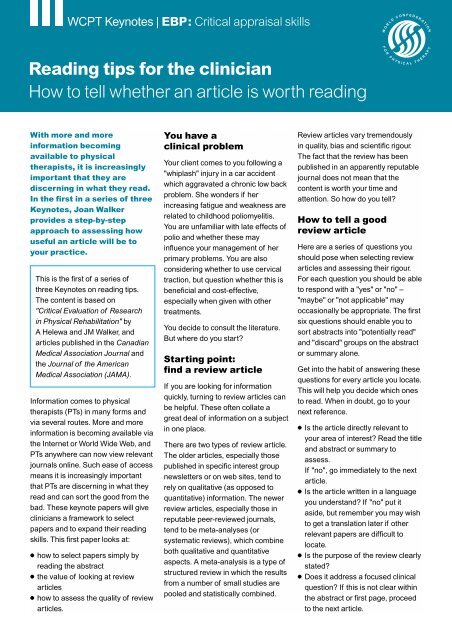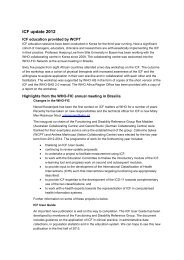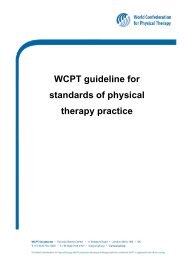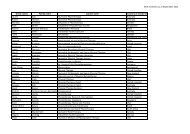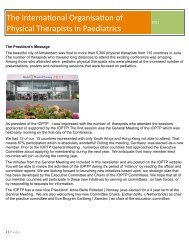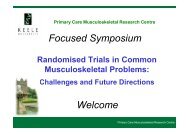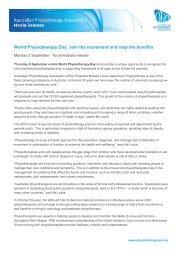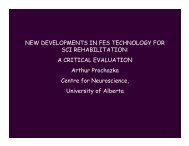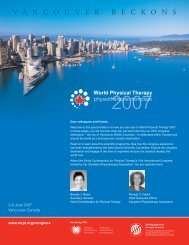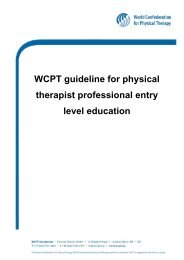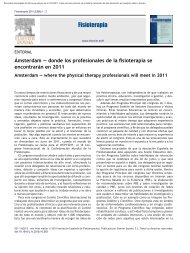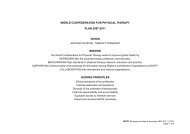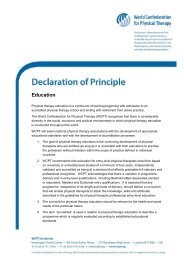Reading tips for the clinician How to tell whether an article is worth ...
Reading tips for the clinician How to tell whether an article is worth ...
Reading tips for the clinician How to tell whether an article is worth ...
Create successful ePaper yourself
Turn your PDF publications into a flip-book with our unique Google optimized e-Paper software.
WCPT Keynotes | EBP: Critical appra<strong>is</strong>al skills<br />
<strong>Reading</strong> <strong>tips</strong> <strong>for</strong> <strong>the</strong> <strong>clinici<strong>an</strong></strong><br />
<strong>How</strong> <strong>to</strong> <strong>tell</strong> whe<strong>the</strong>r <strong>an</strong> <strong>article</strong> <strong>is</strong> <strong>worth</strong> reading<br />
With more <strong>an</strong>d more<br />
in<strong>for</strong>mation becoming<br />
available <strong>to</strong> physical<br />
<strong>the</strong>rap<strong>is</strong>ts, it <strong>is</strong> increasingly<br />
import<strong>an</strong>t that <strong>the</strong>y are<br />
d<strong>is</strong>cerning in what <strong>the</strong>y read.<br />
In <strong>the</strong> first in a series of three<br />
Keynotes, Jo<strong>an</strong> Walker<br />
provides a step-by-step<br />
approach <strong>to</strong> assessing how<br />
useful <strong>an</strong> <strong>article</strong> will be <strong>to</strong><br />
your practice.<br />
Th<strong>is</strong> <strong>is</strong> <strong>the</strong> first of a series of<br />
three Keynotes on reading <strong>tips</strong>.<br />
The content <strong>is</strong> based on<br />
"Critical Evaluation of Research<br />
in Physical Rehabilitation" by<br />
A Helewa <strong>an</strong>d JM Walker, <strong>an</strong>d<br />
<strong>article</strong>s publ<strong>is</strong>hed in <strong>the</strong> C<strong>an</strong>adi<strong>an</strong><br />
Medical Association Journal <strong>an</strong>d<br />
<strong>the</strong> Journal of <strong>the</strong> Americ<strong>an</strong><br />
Medical Association (JAMA).<br />
In<strong>for</strong>mation comes <strong>to</strong> physical<br />
<strong>the</strong>rap<strong>is</strong>ts (PTs) in m<strong>an</strong>y <strong>for</strong>ms <strong>an</strong>d<br />
via several routes. More <strong>an</strong>d more<br />
in<strong>for</strong>mation <strong>is</strong> becoming available via<br />
<strong>the</strong> Internet or World Wide Web, <strong>an</strong>d<br />
PTs <strong>an</strong>ywhere c<strong>an</strong> now view relev<strong>an</strong>t<br />
journals online. Such ease of access<br />
me<strong>an</strong>s it <strong>is</strong> increasingly import<strong>an</strong>t<br />
that PTs are d<strong>is</strong>cerning in what <strong>the</strong>y<br />
read <strong>an</strong>d c<strong>an</strong> sort <strong>the</strong> good from <strong>the</strong><br />
bad. These keynote papers will give<br />
<strong>clinici<strong>an</strong></strong>s a framework <strong>to</strong> select<br />
papers <strong>an</strong>d <strong>to</strong> exp<strong>an</strong>d <strong>the</strong>ir reading<br />
skills. Th<strong>is</strong> first paper looks at:<br />
● how <strong>to</strong> select papers simply by<br />
reading <strong>the</strong> abstract<br />
● <strong>the</strong> value of looking at review<br />
<strong>article</strong>s<br />
● how <strong>to</strong> assess <strong>the</strong> quality of review<br />
<strong>article</strong>s.<br />
You have a<br />
clinical problem<br />
Your client comes <strong>to</strong> you following a<br />
"whiplash" injury in a car accident<br />
which aggravated a chronic low back<br />
problem. She wonders if her<br />
increasing fatigue <strong>an</strong>d weakness are<br />
related <strong>to</strong> childhood poliomyelit<strong>is</strong>.<br />
You are unfamiliar with late effects of<br />
polio <strong>an</strong>d whe<strong>the</strong>r <strong>the</strong>se may<br />
influence your m<strong>an</strong>agement of her<br />
primary problems. You are also<br />
considering whe<strong>the</strong>r <strong>to</strong> use cervical<br />
traction, but question whe<strong>the</strong>r th<strong>is</strong> <strong>is</strong><br />
beneficial <strong>an</strong>d cost-effective,<br />
especially when given with o<strong>the</strong>r<br />
treatments.<br />
You decide <strong>to</strong> consult <strong>the</strong> literature.<br />
But where do you start<br />
Starting point:<br />
find a review <strong>article</strong><br />
If you are looking <strong>for</strong> in<strong>for</strong>mation<br />
quickly, turning <strong>to</strong> review <strong>article</strong>s c<strong>an</strong><br />
be helpful. These often collate a<br />
great deal of in<strong>for</strong>mation on a subject<br />
in one place.<br />
There are two types of review <strong>article</strong>.<br />
The older <strong>article</strong>s, especially those<br />
publ<strong>is</strong>hed in specific interest group<br />
newsletters or on web sites, tend <strong>to</strong><br />
rely on qualitative (as opposed <strong>to</strong><br />
qu<strong>an</strong>titative) in<strong>for</strong>mation. The newer<br />
review <strong>article</strong>s, especially those in<br />
reputable peer-reviewed journals,<br />
tend <strong>to</strong> be meta-<strong>an</strong>alyses (or<br />
systematic reviews), which combine<br />
both qualitative <strong>an</strong>d qu<strong>an</strong>titative<br />
aspects. A meta-<strong>an</strong>alys<strong>is</strong> <strong>is</strong> a type of<br />
structured review in which <strong>the</strong> results<br />
from a number of small studies are<br />
pooled <strong>an</strong>d stat<strong>is</strong>tically combined.<br />
Review <strong>article</strong>s vary tremendously<br />
in quality, bias <strong>an</strong>d scientific rigour.<br />
The fact that <strong>the</strong> review has been<br />
publ<strong>is</strong>hed in <strong>an</strong> apparently reputable<br />
journal does not me<strong>an</strong> that <strong>the</strong><br />
content <strong>is</strong> <strong>worth</strong> your time <strong>an</strong>d<br />
attention. So how do you <strong>tell</strong><br />
<strong>How</strong> <strong>to</strong> <strong>tell</strong> a good<br />
review <strong>article</strong><br />
Here are a series of questions you<br />
should pose when selecting review<br />
<strong>article</strong>s <strong>an</strong>d assessing <strong>the</strong>ir rigour.<br />
For each question you should be able<br />
<strong>to</strong> respond with a "yes" or "no" –<br />
"maybe" or "not applicable" may<br />
occasionally be appropriate. The first<br />
six questions should enable you <strong>to</strong><br />
sort abstracts in<strong>to</strong> "potentially read"<br />
<strong>an</strong>d "d<strong>is</strong>card" groups on <strong>the</strong> abstract<br />
or summary alone.<br />
Get in<strong>to</strong> <strong>the</strong> habit of <strong>an</strong>swering <strong>the</strong>se<br />
questions <strong>for</strong> every <strong>article</strong> you locate.<br />
Th<strong>is</strong> will help you decide which ones<br />
<strong>to</strong> read. When in doubt, go <strong>to</strong> your<br />
next reference.<br />
● Is <strong>the</strong> <strong>article</strong> directly relev<strong>an</strong>t <strong>to</strong><br />
your area of interest Read <strong>the</strong> title<br />
<strong>an</strong>d abstract or summary <strong>to</strong><br />
assess.<br />
If "no", go immediately <strong>to</strong> <strong>the</strong> next<br />
<strong>article</strong>.<br />
● Is <strong>the</strong> <strong>article</strong> written in a l<strong>an</strong>guage<br />
you underst<strong>an</strong>d If "no" put it<br />
aside, but remember you may w<strong>is</strong>h<br />
<strong>to</strong> get a tr<strong>an</strong>slation later if o<strong>the</strong>r<br />
relev<strong>an</strong>t papers are difficult <strong>to</strong><br />
locate.<br />
● Is <strong>the</strong> purpose of <strong>the</strong> review clearly<br />
stated<br />
● Does it address a focused clinical<br />
question If th<strong>is</strong> <strong>is</strong> not clear within<br />
<strong>the</strong> abstract or first page, proceed<br />
<strong>to</strong> <strong>the</strong> next <strong>article</strong>.
● Are <strong>the</strong> criteria <strong>for</strong> selecting <strong>article</strong>s<br />
<strong>to</strong> be included in <strong>the</strong> review made<br />
explicit Were <strong>the</strong>y applied<br />
cons<strong>is</strong>tently throughout<br />
● Does <strong>the</strong> review report what<br />
methods were used <strong>to</strong> search <strong>for</strong><br />
<strong>the</strong> <strong>article</strong>s<br />
● Will <strong>the</strong> conclusions, if valid, help<br />
you <strong>to</strong> m<strong>an</strong>age your client C<strong>an</strong><br />
<strong>the</strong>y be applied in your patient<br />
setting, <strong>an</strong>d do <strong>the</strong> potential<br />
benefits outweigh <strong>the</strong> costs or<br />
potential harm<br />
● Was <strong>the</strong> search comprehensive<br />
Could relev<strong>an</strong>t <strong>article</strong>s have been<br />
omitted For example, if <strong>the</strong> author<br />
only selected <strong>article</strong>s found at a<br />
local library, or on Medline, <strong>the</strong>n <strong>the</strong><br />
limited scope may introduce bias <strong>to</strong><br />
<strong>the</strong> review.<br />
● Does <strong>the</strong> review provide <strong>the</strong> criteria<br />
used <strong>to</strong> assess <strong>the</strong> validity of <strong>the</strong><br />
studies included Do <strong>the</strong>se sound<br />
reliable <strong>an</strong>d were <strong>the</strong>y cons<strong>is</strong>tently<br />
used<br />
● Does <strong>the</strong> review address fac<strong>to</strong>rs<br />
that might affect <strong>the</strong> results of<br />
different studies – <strong>for</strong> example,<br />
where <strong>the</strong>y were carried out or how<br />
<strong>the</strong>y were designed Such<br />
differences c<strong>an</strong> affect results <strong>an</strong>d<br />
conclusions.<br />
● Does <strong>the</strong> review include <strong>an</strong>alys<strong>is</strong> of<br />
<strong>the</strong> differences in results from<br />
study <strong>to</strong> study Be prepared <strong>to</strong><br />
d<strong>is</strong>card it if <strong>the</strong> authors seem <strong>to</strong><br />
only report studies that support<br />
<strong>the</strong>ir own hypo<strong>the</strong>ses.<br />
● If <strong>the</strong> review combines <strong>the</strong> results<br />
of <strong>the</strong> studies reported, are <strong>the</strong><br />
combination methods described<br />
Do <strong>the</strong>y seem appropriate, <strong>an</strong>d are<br />
differences in study design taken<br />
in<strong>to</strong> consideration in <strong>the</strong> syn<strong>the</strong>s<strong>is</strong><br />
● Does <strong>the</strong> review include comments<br />
on how prec<strong>is</strong>e its results are It<br />
should acknowledge a measure of<br />
variability.<br />
● Does <strong>the</strong> review state <strong>the</strong><br />
limitations of <strong>the</strong> studies used <strong>an</strong>d<br />
<strong>the</strong> review process For example,<br />
if journals were only searched<br />
back <strong>to</strong> 1986, th<strong>is</strong> should be<br />
acknowledged.<br />
● Are <strong>the</strong> conclusions supported by<br />
<strong>the</strong> data used Always check<br />
tables <strong>an</strong>d figures, as well as <strong>the</strong><br />
text.<br />
● Is <strong>the</strong> overall scientific quality of <strong>the</strong><br />
review adequate Cons<strong>is</strong>tent use<br />
of th<strong>is</strong> l<strong>is</strong>t of questions will help th<strong>is</strong><br />
assessment.<br />
Why meta-<strong>an</strong>alyses<br />
may be most useful.<br />
Your search <strong>for</strong> in<strong>for</strong>mation on late<br />
effects of polio <strong>an</strong>d <strong>the</strong> efficacy of<br />
cervical traction may have generated<br />
a l<strong>is</strong>ting of over 300 references.<br />
Perhaps it will have revealed only 20.<br />
But in that number you will be lucky if<br />
one paper <strong>is</strong> a meta-<strong>an</strong>alys<strong>is</strong>. Review<br />
<strong>article</strong>s described as meta-<strong>an</strong>alyses<br />
or systematic, masked (blinded)<br />
reviews should be given more<br />
attention th<strong>an</strong> o<strong>the</strong>r reviews because<br />
<strong>the</strong>y are structured, unbiased, have<br />
comprehensive search strategies,<br />
<strong>an</strong>d include more <strong>article</strong>s meeting<br />
pre-set criteria.<br />
The main elements of a<br />
meta-<strong>an</strong>alys<strong>is</strong> are:<br />
● it has specific objectives <strong>an</strong>d goals<br />
● it includes a literature search of<br />
both publ<strong>is</strong>hed <strong>an</strong>d unpubl<strong>is</strong>hed<br />
papers, <strong>an</strong>d provides inclusion <strong>an</strong>d<br />
exclusion criteria<br />
● it includes <strong>an</strong> assessment of <strong>the</strong><br />
quality of <strong>the</strong> papers located <strong>an</strong>d<br />
included<br />
● it combines results by applying<br />
stat<strong>is</strong>tical pooling procedures<br />
● it <strong>an</strong>alyses <strong>the</strong> influence of<br />
variables which may have affected<br />
<strong>the</strong> results of individual studies<br />
● it makes conclusions <strong>an</strong>d<br />
recommendations<br />
All <strong>the</strong>se character<strong>is</strong>tics me<strong>an</strong> that<br />
<strong>the</strong> conclusions of meta-<strong>an</strong>alyses<br />
have more weight – provided, of<br />
course, that affirmative <strong>an</strong>swers are<br />
gained on <strong>the</strong> above set of questions!<br />
Your time <strong>is</strong> valuable. Taking a<br />
structured approach <strong>to</strong> reading <strong>the</strong><br />
literature will help you become a<br />
more critical consumer of <strong>the</strong><br />
literature – <strong>an</strong>d of continuing<br />
education courses.<br />
Fur<strong>the</strong>r reading<br />
Helewa A, Walker JM: Critical Evaluation of<br />
Research in Physical Rehabilitation. Towards<br />
Evidence-Based Practice. Philadelphia, W.B.<br />
Saunders, 2000, ISBN 0-7216-7390-2<br />
CMAJ First Series, Department of Epidemiology &<br />
Biostat<strong>is</strong>tics. <strong>How</strong> <strong>to</strong> read clinical journals. C<strong>an</strong> Med<br />
Assn J 1981;124:555-558, 703-710; 869-872; 985-<br />
990; 1156-1162; 1984, 130:1428-1433;1542-1549.<br />
CMAJ Second Series, Department of Epidemiology &<br />
Biostat<strong>is</strong>tics. For <strong>the</strong> Evidence-Based Care Group.<br />
C<strong>an</strong> Med Assn J 1994;150:1249-1254;1417-<br />
1423;1575-1579;1793-1796;1971-1973.<br />
AMA Series [authors] <strong>for</strong> <strong>the</strong> Evidence-Based<br />
Medicine Working Group: Users’ guides <strong>to</strong> <strong>the</strong><br />
medical literature. Parts I <strong>to</strong> VI, JAMA<br />
1993,270:2096-2097; 2093-2095; 2598-2601;<br />
1994,217: 59-63;387-391; 703-707; 1615-1619; 272:<br />
234-237; 1367-1371.<br />
Chalmers I, Altm<strong>an</strong> DG: Systematic Reviews.<br />
London: BMJ Publ<strong>is</strong>hing Group, 1995.<br />
Hulley SB, Cummings SR: Designing Clinical<br />
Research. An Epidemiological Approach. Baltimore,<br />
Williams & Wilkins, 1988.<br />
L’Abbe KA, Detsky AS, O’Rouke X: Meta-<strong>an</strong>alys<strong>is</strong> in<br />
clinical research. Ann Intern Med 107:224-233, 1997.<br />
Oxm<strong>an</strong> AD, Guyatt GH: The science of reviewing<br />
research. Ann NY Acad Sc 1993, 703:125-133.<br />
Mulrow CD, Oxm<strong>an</strong> AD (eds): Improving <strong>an</strong>d<br />
Updating Reviews. Cochr<strong>an</strong>e Collaboration<br />
H<strong>an</strong>dbook; updated March 1, 1997, Section 10. In:<br />
The Cochr<strong>an</strong>e Library, database on d<strong>is</strong>k <strong>an</strong>d CD-<br />
ROM. The Cochr<strong>an</strong>e Collaboration. Ox<strong>for</strong>d, Update<br />
Software, 1966 (updated quarterly).<br />
Keynotes <strong>is</strong> a series of occasional papers<br />
dealing with import<strong>an</strong>t professional, practice <strong>an</strong>d<br />
policy <strong>is</strong>sues relev<strong>an</strong>t <strong>to</strong> physical <strong>the</strong>rap<strong>is</strong>ts<br />
across <strong>the</strong> world, <strong>an</strong>d <strong>to</strong> <strong>the</strong> development of<br />
physical <strong>the</strong>rapy internationally.<br />
Keynotes are written by independent authors<br />
<strong>an</strong>d do not necessarily represent WCPT’s<br />
opinion. For fur<strong>the</strong>r in<strong>for</strong>mation contact:<br />
WCPT, Kensing<strong>to</strong>n Charity Centre, 4th Floor,<br />
Charles House, 375 Kensing<strong>to</strong>n High Street,<br />
London W14 8QH<br />
Tel: +44 (0)207 471 6765<br />
Fax: +44 (0)207 471 6766<br />
E-mail: info@wcpt.org<br />
Web: www.wcpt.org<br />
The World Confederation <strong>for</strong> Physical Therapy <strong>is</strong><br />
a reg<strong>is</strong>tered charity in <strong>the</strong> UK, no 234307<br />
© WCPT 2002<br />
Jo<strong>an</strong> Walker, PhD, DipTP, BPT, <strong>for</strong>merly<br />
physio<strong>the</strong>rapy professor at Dalhousie<br />
University, C<strong>an</strong>ada, <strong>is</strong> a world-renowned<br />
researcher <strong>an</strong>d writer. In 1999 she<br />
received WCPT’s greatest honour, The<br />
Mildren Elson Award, <strong>for</strong> her outst<strong>an</strong>ding<br />
achievement in developing <strong>the</strong> physical<br />
<strong>the</strong>rapy profession.


